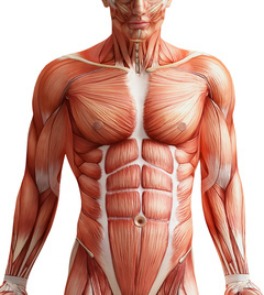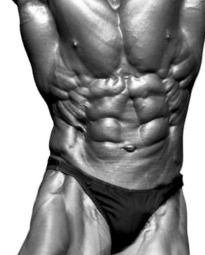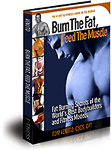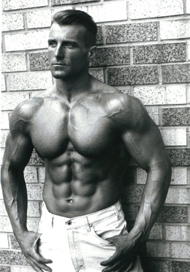Title:How To Get Your Abs To “POP” Out: The Real Secrets To Exposing Your Six Pack
URL: www.BurnTheFat.com!
By: Tom Venuto
words:2523

Q: I’ve managed to get my body fat down to about 6.5%, according to my calipers. I’m starting to see the outline of my abs in certain lighting conditions, but they certainly don’t pop out like a washboard. I must also say that I’ve only been training them with a vengeance in the last 4 months. What I’m wondering is do I keep trying to lose more body fat to expose them, and will this level of body fat be sustainable, or do I increase my calories on the basis of increasing the muscle size of the abs to expose them?
A: EXPOSING YOUR ABS is a matter of getting very low body fat levels. The lower your body fat level, the “thinner” your skin will be (actually the “skinfold” which contains skin and subcutaneous fat), and the more your abdominal musculature will show through.
DEVELOPING YOUR ABS – is a matter of training, and in that respect, the popular maxim “abs are made in the kitchen, not in the gym” is not entirely true. It’s only true that without the proper diet (“kitchen”), the ab exercises by themselves are useless because well-developed abs can remain covered up with a layer of fat and it’s possible to out-eat any amount of exercise.
I’ve discovered that there are two personality types with regards to getting great abs…
Personality A is the person with the mindset that, “as long as I get super lean, my abs will show,” so they blow off ab workouts or train them very minimally thinking they will have ab EXPOSURE and ab DEVELOPMENT just by being lean.
Personality B (which includes a lot of women) is the type of person who cranks out a 30 minute or even a one HOUR ab class every day, but they’re not informed about the importance of low body fat – or they are, but they don’t put the effort into nutrition so they never get their body fat low enough.
Here’s the true secret of exposing your abs and getting them to “pop out” more: It’s absolutely a combination of both – low body fat to EXPOSE aka UNCOVER them (reveal the muscle that’s already under there), and training to DEVELOP the ab muscles, aka build what is not there yet.
Some people find abdominal development difficult. I’ve always found it easy – the removal of the fat was the harder part for me. It took me years before I figured it out. The good news is, after I learned how to get ripped just once, I owned it for life. It’s like riding a bicycle – you can always get back on and ride even if you haven’t ridden for years, once you know how.
So which personality type are you? Are you toiling away like the girl in the class with an hour of abs a day (utterly unnecessary and a TOTAL waste of time) but you still can’t see enough abs because your skinfolds are too thick, or are you personality B – youre super strict on nutrition and you are very lean but you’re still frustrated with your abs because they don’t pop like you want them to… meanwhile, you blow off ab workouts or treat them as an afterthought… a few sets at the end of your real manly workout: chest and biceps!
Or… are you personality C? That’s the person who takes nutrition (revealing the abs) and training (developing the abs) as equally important and can recognize which area needs the work. Personality C always gets the best results.
The Value of Body Fat Percentage Vs. Skinfold Measurements
Another suggestion I have is not to put so much stock in the body fat number by itself. That number is valuable for tracking your week to week fat loss progress, assuming you can measure consistently. The number itself is worth nothing but bragging rights if it’s low, because for one thing, man A can look RIPPED at 9% body fat while man B may not look ripped until 5-6% body fat.
Furthermore, the body fat percentage measurement doesn’t tell you how thick your skinfold is. Some people are tracking overall body fat percentage, but not paying much attention to the individual skinfolds. It’s very possible for skinfolds on the extremities and even in the hip bone area (illiac crest skinfold site) to be quite low and to have body fat more concentrated in the abdominal area near the umbilicus.
In trying to figure out if you need to get leaner and get “thinner skin” to reveal your abs more, you should not just look at bf% but also the actual skinfold thickness in the abdominal area.
This means that skinfold testing is more useful than bodyfat testing methods like bioelectric impedance analysis when youre trying to gauge your progress in getting your abs to pop because you literally know the skinfold thickness covering the abs. Measure skinfolds as well as body fat percentage and you have more feedback to judge progress. What gets measured gets improved.
For example, an illiac crest skinfold of 3.5 mm is ULTRA LEAN. That skinfold is not going to get much lower than 2.0 to 2.5 mm because that’s the approximate thickness of skin, without the fat. I dont recall seeing below 2 mm except on a scant few occasions when I had a digital SKYDEX caliper which can show readings like 1.9 mm or 1.7 mm.
But also remember, that the illiac crest usually becomes the Lowest skinfold. Let’s stop kidding ourselves. Two areas on a guy retain more fat than the illiac crest: One is the circular area right around your belly button – just draw an imaginary circle around it and there is almost always a pocket of fat there EVEN when the illiac crest fat has “run dry” and even when the very lower lower ab region is starting to show veins.
If you have veins running across your belly button area and your abdominal skinfold is 2.0 to 3.0 you are bloody ripped. The abdominal skinfold is usually at least a few millimeters higher than the iliac crest. Your abs are showing as much as they’re going to show – if you want them to look different, it’s all training at that point.
The other “stubborn” area is the love handes and lower back. Reach around and pinch, not gingerly, but for real – grab the biggest hunk of skinfold you can around the side of your waist, toward your back. Tell me it isn’t WAY bigger than the illiac pinch? But guess what – that’s not an official skinfold site at all.
If you want to be brutally honest with yourself on your level of leanness, find the largest skinfold and use that as your benchmark, not your smallest skinfold. Testing the abdominal skinfold and keeping an eye on the umbilicus area is most telling. It certainly is for me…
I could (sometimes ashamedly) show you pictures ON STAGE – day of contest where I was ripped head to toe and looked great all over except that one little spot right around the belly button was retaining the last bit of fat even at sub 5%-6% body fat. I didn’t quite have that “shrink-wrapped,” “drum-tight” skin there yet.
Abdominal Shape and Genetics: What Training Can and Cannot Change
As for DEVELOPING the abs more – that’s achieved with training, and though I realize that some people say they have a tough time getting the abs to develop, I’ve always found abdominals easy to develop. Achieving the low body fat (the “revaling” abs) part was harder than the developing abs part for me and I think that’s true for a lot of people. Admittedly, this is partially related to genetics. Some people have “easy to develop muscles” (mesomorphs) and some have “hard to develop muscles” and that’s dictated by genetics on an individual level.
But one thing you have to realize, is that whether you have the best or the worst genetic potential for muscle size, the structure of your abdominal musculature is entirely genetic. NOT EVERYONE HAS A PERFECT 6-PACK. The six pack is three rows of rectus abdominus separated by tendinous horizontal bands and one large tendinous band down the middle called the linea alba.

Some guys have a wide and deep lina alba, to the point it looks like a gap. That’s not necessarily a bad thing, it’s just an individual’s genetically given muscle shape.
Some people have only 2 visible rows of abs and below that where the 3rd row is usually located is only a flat sheet of tendinous tissue – no 3rd row. Others have 4 visible rows if you count the lowermost portion of the abs – an 8 pack. Some people consider having the 8-pack being the ultimate in “genetic freakiness.”
Some people have even rows of abs horizontally, while others have the abs offset as in slightly “checkered.” Some people consider the even rows to be more aesthetically pleasing (though there have been plenty of Mr. America’s, Mr. Universes and Mr. Olympia’s who did NOT have even rows of abs).
Ladies and gentlemen – YOU CANNOT CHANGE ANY OF THIS! If you have a 4 pack, all you can do is develop the 4 pack you have. You can make that 4-pack “pop out” more, but you can’t build a 3rd row for a 6 pack where there is no muscle fiber to begin with. If you have a 6 pack with even rows, you are considered genetically gifted, at least in a muscle aesthetics sense. If you have a nice, even 8 pack, then we are probably going to call you a genetic freak, LOL!
If you have a deep and wide linea alba you can’t change that either. Some people think that is not aesthetically pleasing, but on the other hand, it does manifest itself as a “deep cut” down the middle, so and even if some people dont like those aesthetics, the wide linea alba does makes your abs POP.
Developing Abdominal Muscle Size
Given that you understand the limitations of your genetics, the abdominal muscle fibers that you DO have can be developed like any other muscles – they can hypertrophy with direct training. The difference between the abs and other muscles is that the abs don’t grow OUT so much as a muscle with a large muscle “BELLY” because the abs are literally a long flat sheet, whereas a bicep is a muscle with a large belly and therefore will “plump out” and become more round and peaked (“popping out” literally), as it hypertrophies.
Last but not least, can you develop your lower abs amd make them pop more, to the exclusion of your upper abs? NO they cannot be isolated completely. Can you put more emphasis on your lower abs than the upper abs with exercise choice? That is very likely, but that is also controversial. You have guys like Dr. Stuart McGill, one of the worlds TOP experts on spine biomechanics and if he speaks, many trainers receive his words as if they were the word of God. When highly regarded experts like McGill say you can’t train your lower abs (apart from upper abs), then that’s it, you can’t work them, say a large group of trainers.
But not everyone agrees with that. Some trainers argue that there are different innervation points for different segments of the adbominals. Others point to EMG studies which show greater activation of the lower abdominals (the EMG studies may be controversial, but most experts DO agree that some “ab” exercises activate the obliques more than the abdominals, so it’s not like you can only work your abdominal region as if it were one giant region of muscle – different exercises DO have different effects.
Most bodybuilders and many trainers believe that some exercises activate the lower abs more. Usually these are the exercises that bring the legs toward the upper body and or tilt the pelvis posteriorly. These include hanging knee ups, hanging leg raises and reverse crunches. Keeping in mind what I mentioned about 4 packs vs 6 packs and 8 packs, these exercises may help bring out the washboard appearance and make your abs pop more by putting more stress on that bottom row of abs.
Adding weight to abdominal exercise may also help your abs pop, by increasing hypertrophy. The abs are a muscle that can often be trained very effectively just with body weight. The problem is, most people stick with bodyweight exercises exclusively, even when they can do more than 25 reps per set, sometimes even 50 or 100 reps. At that point, you’re training pure endurance and not hypertrophy. Yes, it’s absolutely a myth that endless high reps gives you better abs – you might be better off with lower reps and adding some weight.
I know some girls who can do abs for an hour, it seems (I’ll never figure that one one… guys, unless youre related to Jack LaLanne, don’t try to keep up with those girls who teach ab classes, they will embarrass you, LOL… I bow to women’s ab endurance). But anyway, remember that muscle hypertrophy is achieved in the 8-12 rep range and even if abs are a slighly more higher rep responsive muscle, 15-20 with some weight ouught to do it.
If it’s abdominal muscle development you want, there is simply NO reason whatsoever to do hundreds of reps of ab work. If your goal is endurance or personal satisfaction about your endurance and conditioning abilities, that’s one thing, otherwise doing hundreds of reps on abs with bodyweight is the wrong approach.
Warning: Build Your Abs, But Don’t Build Your Obliques!
I do have one final warning though, about weighted exercises: don’t train your obliques with heavy weight if you’re prone to easy muscle growth there. Exercises like weighted side bends can make your waist larger and blockier and throw off your symmetry.
Pro bodybuilders who are naturally blocky and NOT born with the “Frank Zane tiny waist” and symmetry are not doomed – just look at Jay Cutler, Mr Olympia. However, Jay had to blow up his delotoids up to ridiculous size to compensate visually and be utterly paranoid about doing anything that would make his waist wider. The dual effect of larger wider shoulders and simulaneously shrinking waist size PLUS rectus abdominals development and low body fat is STUNNING!
Conclusion
So, I think I’ve made the case pretty clear that abs are made in the kitchen AND in the gym, not one or the other.
If you’re a freak mesomorph, you might diet down and find that the abs are already there. I know people who never train their abs and they have amazing six packs. On that note, I know people who have freaky calves who never work them either. Chalk up both of those scenarios to genetics.
For most of us in the normal range of the genetic bell curve however, it’s going to take strict diet and hard training to get ultimate abs develoment and see that washboard pop!
Train hard AND eat right, gang!

Tom Venuto, author of
Burn The Fat Feed The Muscle
www.BurnTheFat.com!
Founder & CEO of
Burn The Fat Inner Circle
Burn the fat inner circle
About the Author:
Tom Venuto is the author of the #1 best seller, Burn the
Fat, Feed the Muscle: Fat Burning Secrets of the World’s Best Bodybuilders and
Fitness Models. Tom is a lifetime natural bodybuilder and fat loss expert
who achieved an astonishing 3.7% body fat level without drugs or supplements.
Discover how to increase your metabolism and burn stubborn body fat, find out
which foods burn fat and which foods turn to fat, plus get a free fat loss
report and mini course by visiting Tom’s site at: www.BurnTheFat.com!












